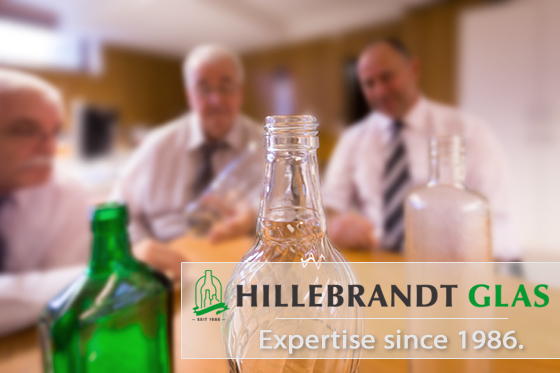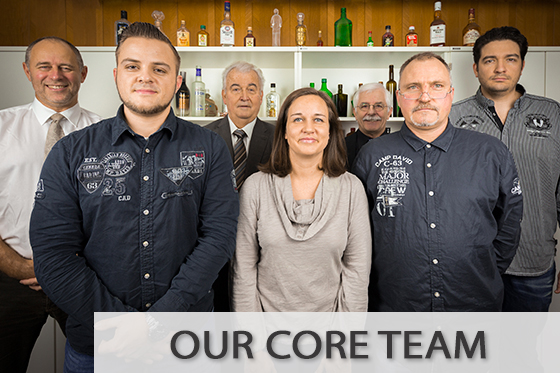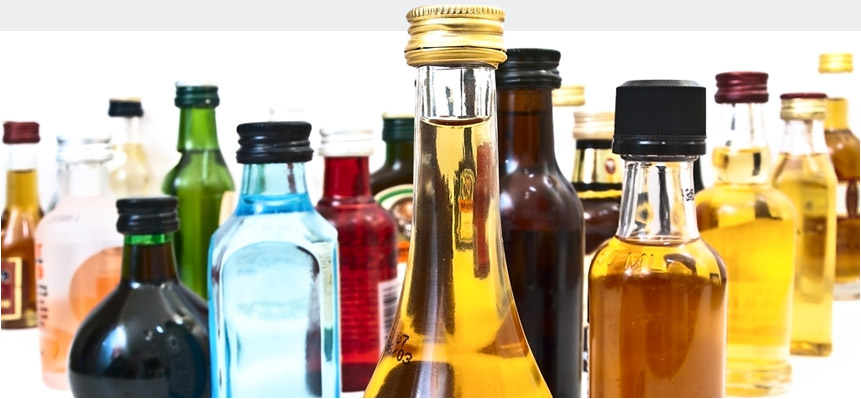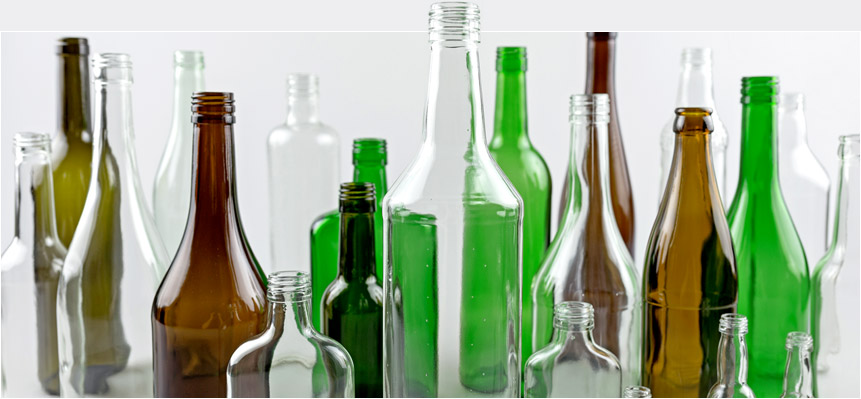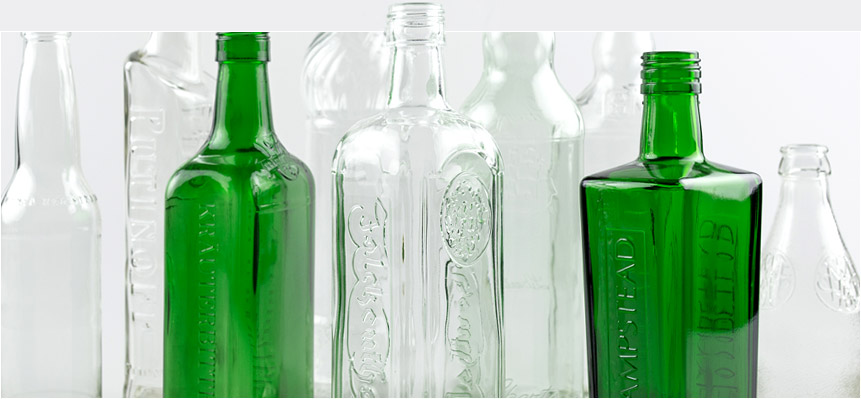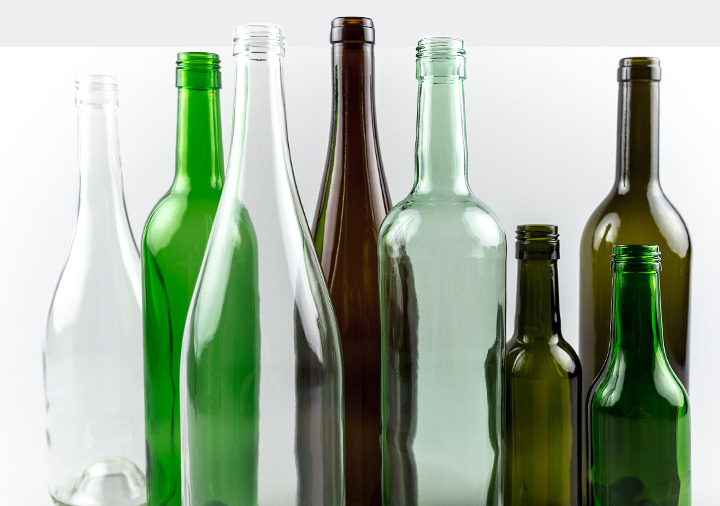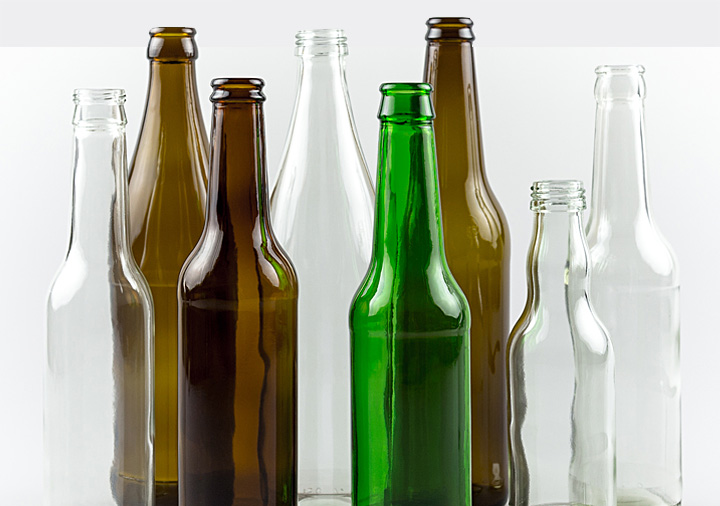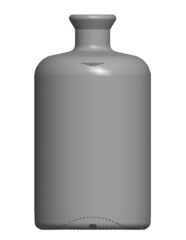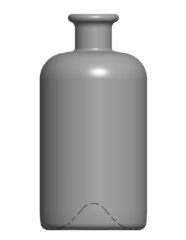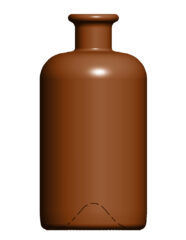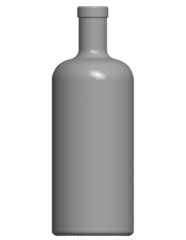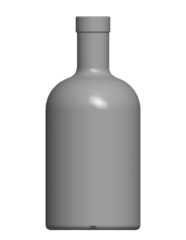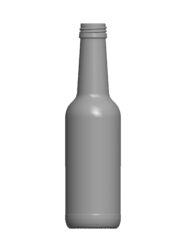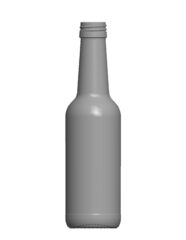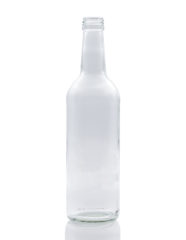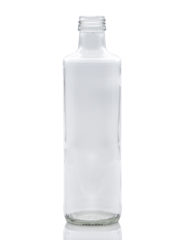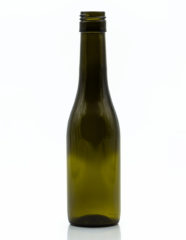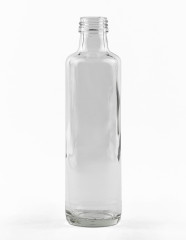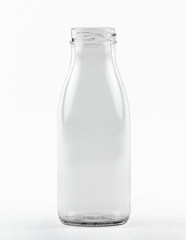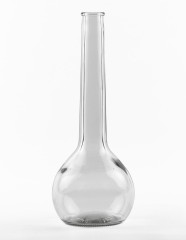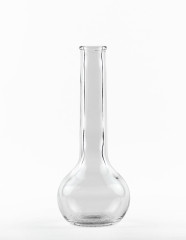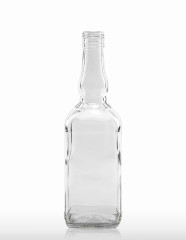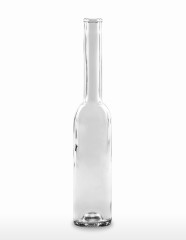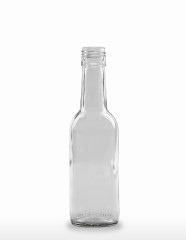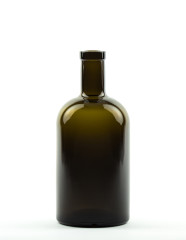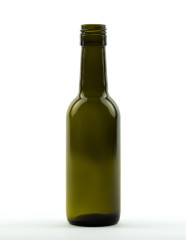Beer bottles
The most commonly used beer bottles in Germany are the 0.5 liter NRW bottle (amber glass) and the 0.5 liter long-neck bottle (amber glass and green glass) for the refillable bottle system. However, there are also one-way variants of both types of bottle which are considerably lighter than the refillable variants as a rule (e.g. for export beers). There is a good reason why the dimensions of the one-way variants differ slightly from those of the refillable bottles – that prevents intermixing within the refillable bottle pool. Unfortunately, it also makes switching over the bottling lines unavoidable when it is necessary to alternate between one-way and refillable bottling. However, the 0.5 Euro bottle (refillable) which predominated in Germany until the late eighties is still of importance at the regional level, even though its market share has declined substantially since then. However, in the meantime some breweries are intentionally choosing to use that variant again as a defining characteristic, and many beer connoisseurs even assert that it is the best bottle shape by far for enjoying beer straight out of the bottle. Quite a few breweries have taken advantage of the wave of nostalgia that has been observed for several years and have sort of “rediscovered” the 0.5 liter Euro bottle.
In the last few years, the larger breweries in particular have switched their bottling over to custom-made bottles, which is definitely a regarded as controversial method by the general public. Even though those custom-made bottles are used within the refillable bottle system, they still lead to substantial additional work and expense as far as empty bottle logistics are concerned. The consequences are increased glass loss within the refillable bottle system and considerably greater expenditures for empties sorting. What long term impact that will have on the general pool of refillable bottles is disputed. On the one hand, one might conclude that higher costs and glass loss will mean that the situation will worsen; by contrast, quite ironically the growing necessity to feed in new glass might also lead to the opposite effect.
However, for some time now the smaller 0.33 liter containers have become more and more popular; especially the amber 0.33 liter long-neck bottle within the refillable bottle system can be found in almost every beverage store today. When the deposit on one-way containers was introduced in Germany on January 1st, 2003, the so-called “six packs” consisting of six 0.33 liter long-neck bottles made a decisive contribution towards giving that variant a huge boost in Germany. As there are no 0.33 liter NRW bottles, the 0.33 liter Vichy bottles have established themselves as the corresponding equivalent in addition to the popular 0.33 liter long-neck bottles (which are also frequently referred to as ale bottles); the 0.33 liter Steinie bottle is also a type of beer bottle that is used quite often and it has even become a trademark for some breweries.
However, the generally anticipated trend towards the even smaller 0.25 liter containers has not materialized up to now; evidently, German beer drinkers are very traditional in that respect. Whereas 0.25 liter Vichy and long-neck bottles play quite an important role in our neighboring countries to the west, they can rarely be found in this country.
It goes without saying that all of the common standard beer bottles mentioned here can be purchased from us. Among others, our product range includes:
- 250 ml long-neck bottles
- 250 ml Vichy bottles
- 330 ml long-neck bottles / ale bottles (one-way and refillable)
- 330 ml Vichy bottles (one-way and refillable)
- 500 ml NRW bottles (one-way and refillable)
- 500 ml long-neck bottles / ale bottles (one-way and refillable)
- 500 ml Euro beer bottles (refillable)
We would be pleased to advise you on the subject of beer bottles, please just ask!
The most widely used beer bottle closure in Germany is still the crown cork. MCA closures (metal cap aluminium), which is the screw top used predominantly in the area of fruit juice and lemonade bottles, are rarely found on beer bottles. However, the twist crown closure, a combination of the two closure systems, has also established itself and in some countries it is by far the most commonly used beer bottle closure. But it is still rarely found in Germany.
One way to seal beer bottles securely and above all practically, which has already been used since the end of the 19th century, was made possible by the invention of the swing top closure. That closure system has remained nearly unchanged up to the present day and is still very popular, not least because of the “craft beers” (i.e. beer brewed according to craftsmanship principles) that have become more and more fashionable. For small and microbreweries it is often the simplest and most workable method, enabling them to offer their beer in securely sealed bottles without great expense.
Generally speaking, the craft beer phenomenon – which originally reached us via America and England – has generated perceptible impetus for the beer market, which had been stagnating or even declining for years, even though in principle it has always been possible to regard a large part of the beer brewed in Germany as craft beer. At any rate, the craft beer movement has clearly demonstrated that beer consumers are also willing to spend considerably more money for a bottle of beer than was generally thought possible. Today purchasing beer in the high-end price segment means that one single bottle of beer can cost as much as an entire case at the discount store!
Of course, this new inclination to indulge in beer enjoyment has not been without an impact on beer bottles, because beer in those price segments requires exclusivity in every respect! Sparkling wine bottles or containers similar to sparkling wine bottles including the closure variants that are customary in that sector have made an appearance in the beer market. In the meantime, bottle manufacturers are increasingly adapting to that special segment and developing special beer bottles for craft beer.
Spirits bottles
There is probably no other beverage segment in which the diversity of bottles is greater than in the case of spirits bottles. Besides probably the greatest variety of shapes in the beverage segment, the sector also uses most of the various container volumes that are available. That is all the more surprising seeing as – unlike non alcoholic beverages (NAB) – packaging regulations stipulate specific nominal volumes, which is no longer the case for NABs. The reason is that there are simultaneously applicable tax and customs laws relating to alcohol content which still differ for specific countries, but in the meantime they have been brought into line for the most part within the EU. Therefore, certain nominal volumes for liquor bottles and wine bottles are stipulated as mandatory by law and the bottlers have to comply with that!
Custom-made bottles shapes have always been widespread in the liquor production sector, although in the meantime increasing industrialization of bottling operations has lead to a boom in standard bottles, which were initially better able to fulfil the increasingly higher requirements placed on processing suitability in the case of high bottling speeds.
In the course of that process, the “Kurzhals” (short-neck) bottles and/or “Krug” (jug-style) bottles initially established themselves in Germany, quite often in the form of an frosted or granulated variant in 0.7 liter and 1.0 liter sizes, but also in a smooth version or as a combination model that is partially frosted and/or partially granulated. However, the classic shape of brandy bottle with various different volumes and colors (usually flint or light green, occasionally also green or more rarely amber) was and still is popular. Square bottles are also still widely used. Somewhat later, vodka bottles with the well-known “Zwiebelturm” appeared on the scene and “Gradhals” (straight-neck) bottles began their triumphant advance. In the meantime, “Gradhals” bottles in particular have become the dominating bottle shape par excellence. Optimally suited for industrial bottling and finishing, a fresh shape and therefore equally suitable for a variety of uses as a brandy bottle, rum bottle and liqueur bottle, there is hardly any major bottler that does not use that shape of bottle. Because of the ever increasing demand, it was possible to produce the bottle cost-effectively and inexpensively; its weight became lighter and lighter. Whereas that bottle still weighed about 500 grams at the outset, today production weights of 330 grams are customary across the board, whereby variants that are even lighter can also be found. However, increasing bottling speeds impose limits on further weight reductions in that context.
Classic “Gradhals” bottles are available with a volume of 0.35 liters, 0.5 liters, 0.7 liters and 1.0 liter. The 0.7 liter “Gradhals” bottle is still the dominating standard bottle in Germany. The 1.0 liter straight-neck bottle is popular in the catering and wholesale sector, but it is not as widespread as the smaller 0.7 liter variant. Well-known everywhere, but in quantities that fall well short of those of the “Gradhals” bottles, there are other standard shapes such as the Napoleon bottles (mostly 0.5 liters and 0.7 liters), various Bordeaux shapes (usually 0.5 liters) as well as Alexander bottles, VDN bottles and vermouth bottles, which are similar in shape to the brandy bottles that have already been mentioned.
In the meantime additional standard shapes have made an appearance in Germany as a result of growing internationalization, frequently together with the liquor characterized by the bottle shape, for example whisky and gin. For example, the standard models also include the “Kropfhals” bottles that are typical of whisky (round and square) as well as gin bottles with their unmistakeable shape. Hillebrandt Glas can offer you nearly all of the standard shapes that are currently typical for advantageous prices.
It is interesting to note that – in spite of extremely reasonable prices – “Kurzhals” and “Gradhals” bottles have only experienced this tremendous boom within Germany. The reasons for that are probably the PP-28 finish, which was used most widely in Germany and the neighboring countries to the east, but to a decreasing extent in our neighboring countries to the west. There the larger PP-30 and PP-31.5 finishes (also only called PP 31) are used predominantly and they are also becoming accepted in Germany as well. In addition, there is a trend towards longer closures (long caps with lengths and/or heights of 44 mm, 50 mm and 60 mm), which have been identified as an important design element of the bottle. We gladly advise our customers in detail about those aspects, as needed.
One area that is of unique importance can be found in the liquor segment sold in small and miniature bottles. Miniature bottles are regarded as those having volumes of less than 0.1 liter; small bottles encompass the range up to 0.2 liters. In the case of miniature bottles, there is just as large a variety of shapes as there is with larger volume containers. Nearly every known standard shape can be found in the miniatures segment; the same applies to custom-made shapes. In this area as well, the variety of shapes is almost infinite!
The situation in the area of 0.1 liter and 0.2 liter bottles is completely different. There are only very few bottle shapes; almost the entire area is covered by so-called flasks (often also referred to as “Flachmänner”). Admittedly, in the meantime some slightly differing shapes, weights and various individual designs do exist in that segment; but the typical basic shape of the flask can be found again and again, dominating the volume category almost completely. Only a few special bottles and/or decorative bottles occasionally make an appearance among the flasks, which can definitely compete with “Gradhals” bottles in Germany as far as the numbers traded are concerned, but they do not account for the same share of turnover in the liquor segment because of their smaller capacities. In the segment consisting of small and miniature bottles, Hillebrandt Glas offers its customers a wide range of products – to some extent exclusive – at excellent prices!
For several years, there has been a certain identifiable move towards custom-made bottles, frequently based closely on standard models and individually enhanced with the aid of lettering and embossing. In particular the trend towards individually designed proprietary brands at discount stores and in the food retail sector has acted as a decisive contribution towards that development. Nevertheless, depending on the customers’ expectations many aspects should be examined thoroughly in the preliminary phase in order to determine whether individually customized bottles or special shape bottles really do pay off. The costs for a project of that kind can be substantial, but occasionally it may even be surprisingly advantageous. We gladly advise our customers in detail in this respect and – together with our customers – we seek a solution for implementation that is just as individual as the desired bottle itself!
Wine bottles
In the wine bottle segment, diversity of color plays the same role as diversity of shape does for spirits bottles. In no other beverage segment does one encounter such a wide diversity of colors as in wine and sparkling wine bottles. Wine bottles can be found in innumerable color nuances from pure flint to flint and semi-flint, Georgia green, light green, green, dead leaf green, olive green, antique green, masson green and blue, including various variations of amber and even black glass. And what cannot be achieved with molten glass can be accomplished with glass decoration and frosting.
However, while there is a huge variety of color and decorative options for wine bottles, the number of bottles shapes is quite straightforward. To the present day, the choice of wine bottle is usually strongly influenced by historical tradition and there is little experimentation as far as bottle shapes are concerned. The reason for that is primarily the promotion of territorial recognition thanks to the small number of bottle shapes which many winemakers still prefer even today.
Thus, the names of most of the bottle shapes are already indicative of their origins. Bordeaux bottles, Rhine wine or hock bottles, Burgundy bottles, “flutes d’Alsace” or Rhine flutes as well as the “Sachsenkeule”, i.e. Saxon club, are just a few examples. Furthermore, quite naturally there are also other typical regional shapes, above all “Bocksbeutel” bottles in Germany, Tokay bottles in Hungary or port bottles in Portugal. However, the bottle shapes that predominate by far are the Bordeaux, Burgundy and Rhine wine style bottles, and the shapes of regional bottles are usually clearly based on them. Custom-made wine bottle shapes are rather rare, individual customization is usually achieved by means of embossing and lettering while largely retaining the standard shapes.
Just as with spirits bottles, nominal volumes are also stipulated as mandatory for wine bottles and the producer and/or bottler must comply with them by law. Since 1977 the volumes (in liters) listed in the following are permissible for non-sparkling wine in bottles within the EU: 0.1 – 0.187 (for aircraft, ships, trains or duty free shops) – 0.25 – 0.375 – 0.5 – 0.75 – 1.0 – 1.5 – 2.0 – 3.0 – 4.0 – 5.0 – 6.0 – (but explicitly not 7.0) – 8.0 – 9.0 – 10.0. The most common nominal volume for wine by far is 0.75 liters.
While glass bottles were sealed with the aid of wooden stoppers wrapped in hemp as of their first appearance in the 17th century and then almost exclusively with natural cork as of the beginning of the 18th century, in the meantime there are far more closure systems. Initially, there was a search for alternatives to natural cork and various plastic materials were discovered in the late seventies. In the late eighties / early nineties, plastic corks (or rather plastic stoppers) really experienced an upswing and became a serious competitor for natural cork to a growing extent. The world of wine bottles experienced perceptibly more change once again when screw top finishes were introduced. The 28-MCA closure established itself in Germany: probably everybody is familiar with the 1.0 liter Rhine wine bottles or the 1.0 liter Bordeaux bottles with 28-MCA closures. The so-called Stelvin closure, which was originally known by the name Stelcap, was already developed in France in the fifties. At that time, that closure with a diameter of not quite approx. 30 mm was already up to 60 mm long and required a special finish, the 30 BVS finish. Although the closure was developed in France, it was used for the first time in practice in Switzerland in 1972. That is why the finish for the special bottles required for it is called Bague Vin Suisse (BVS). Today, it can be said that the BVS-30H60 closure system is the globally dominating closure system for screw top seals and it is becoming more and more widespread. That is why in the meantime nearly all common standard bottles exist with a BVS-30H60 finish.
Customers can obtain a wide range of Bordeaux bottles, Burgundy bottles and Rhine wine bottles with all of the customary volumes, closure types, colors and various heights from us. Besides inexpensive and environmentally friendly light-glass variants, we also offer high-quality, heavier types. Among others, our product range includes:
- 250 ml Bordeaux bottles
- 500 ml Bordeaux bottles
- 500 ml Rhine wine bottles
- 750 ml Bordeaux bottles
- 750 ml Burgundy bottles
- 750 ml Rhine wine bottles
- 1000 ml Rhine wine bottles
- 1000 ml Bordeaux bottles
We would also be pleased to assist you with regard to highly individual solutions and designs in the wine bottle segment.
